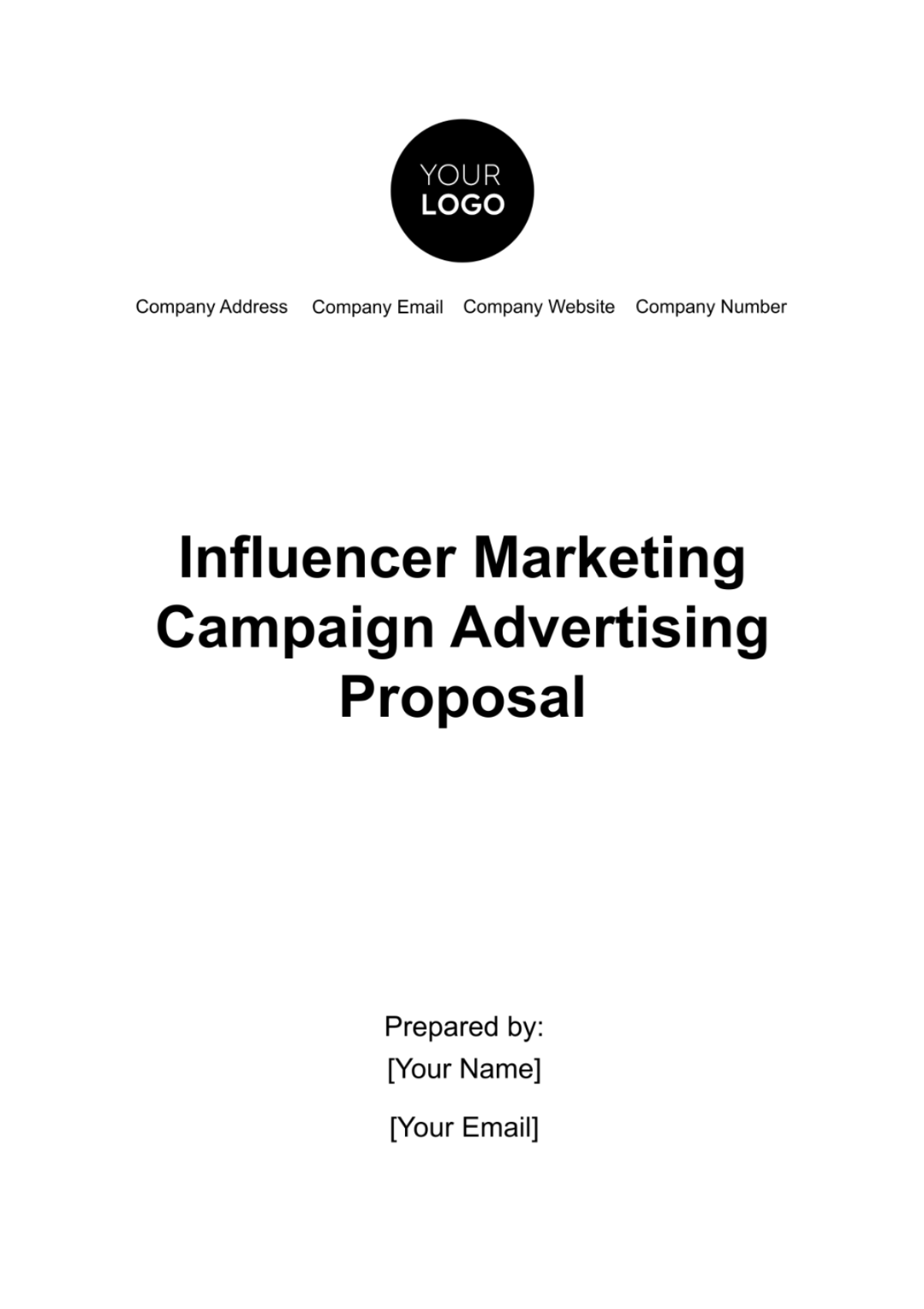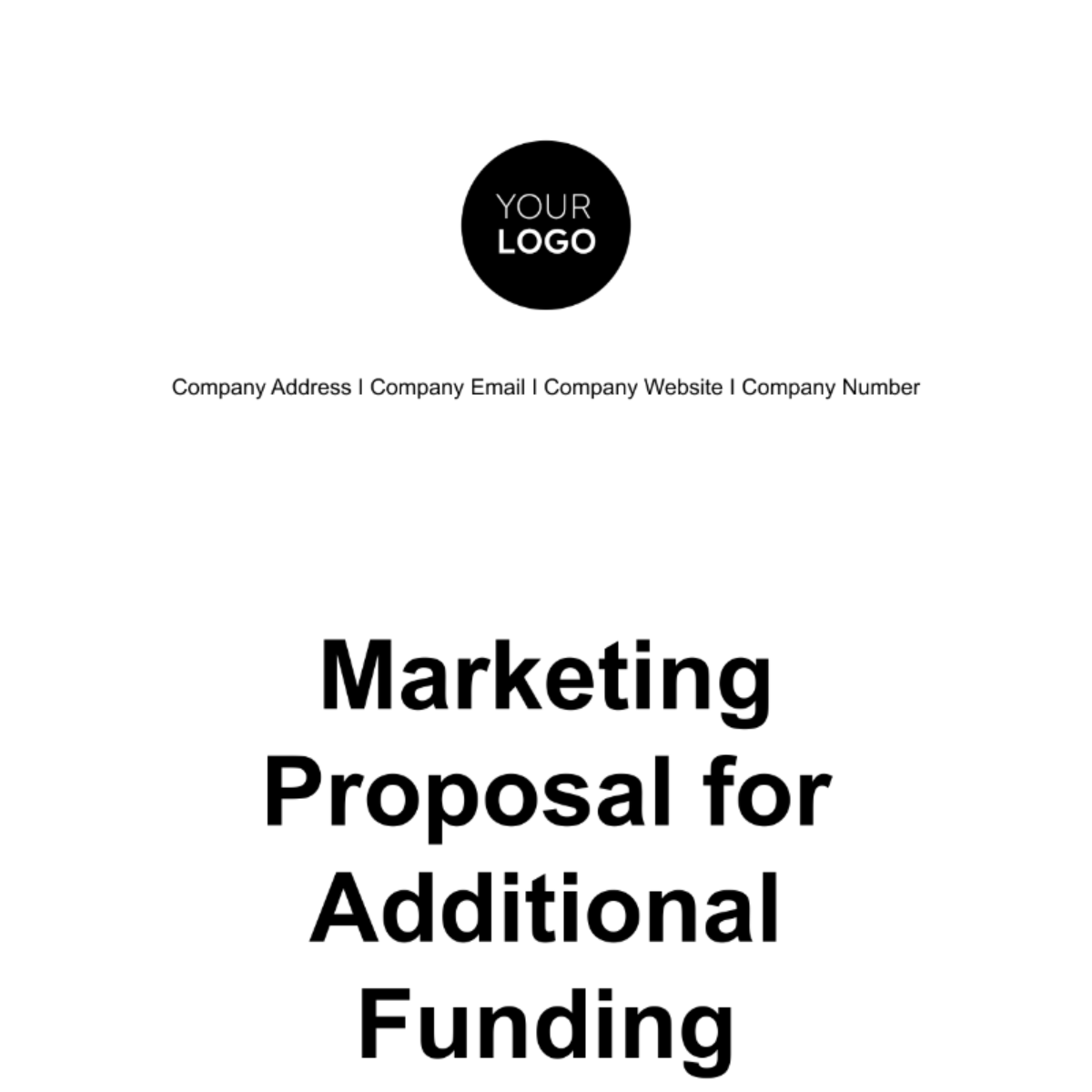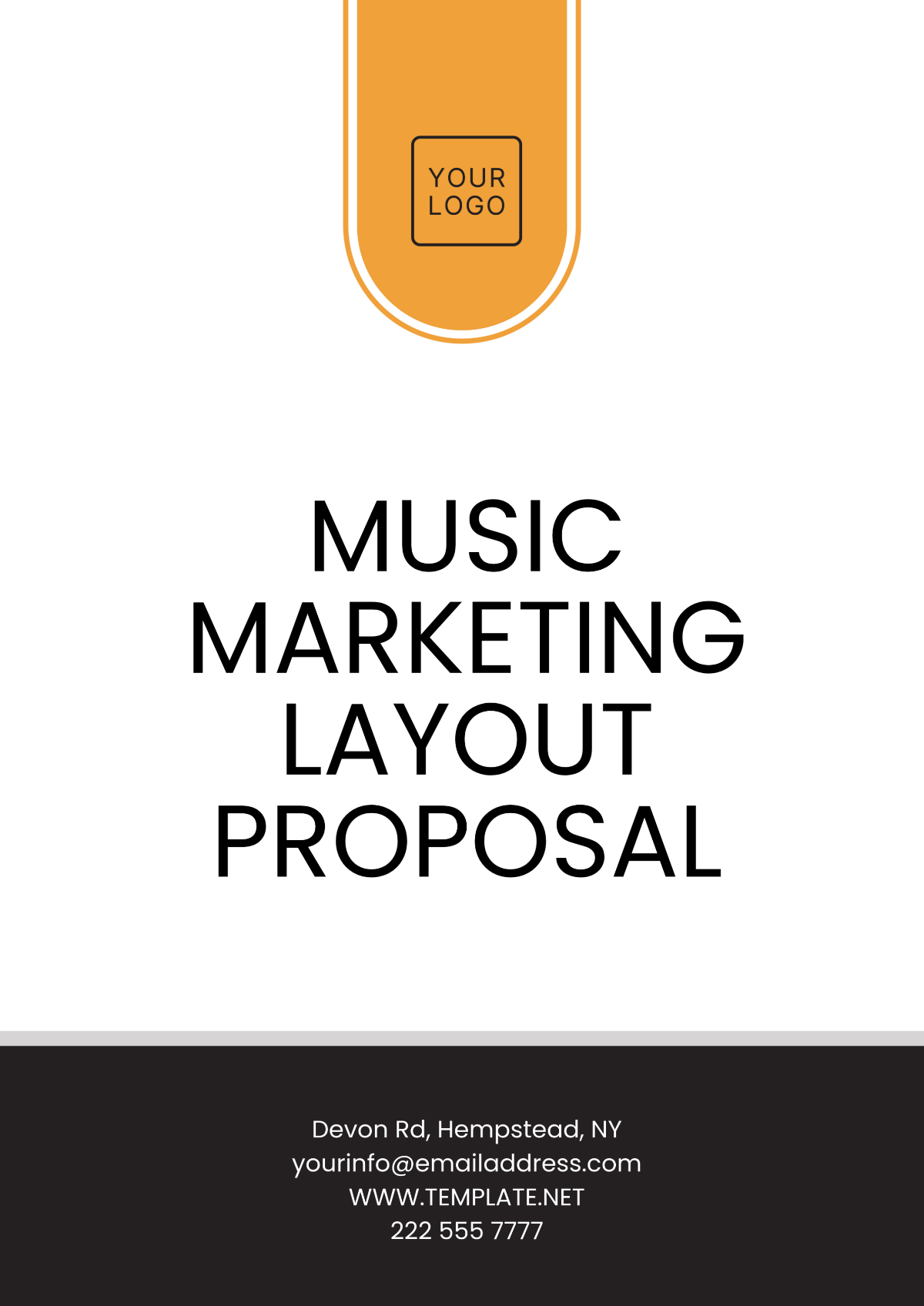Marketing Proposal for Additional Funding
Date Created: [Date] Proposal Version: [00]
EXECUTIVE SUMMARY
At [Your Company Name], we understand the importance of staying ahead of the curve. To ensure our continued success, we are seeking additional funding for a strategic marketing initiative that will elevate our brand presence, drive customer engagement, and boost revenue across various business sectors.
We are living in an era of unprecedented change, and businesses must be adaptable to thrive. As we look forward to 2050 and beyond, the pace of technological evolution, shifts in consumer behavior, and the emergence of new markets will continue to redefine the landscape in which we operate. To remain at the forefront of these changes, we recognize the need for a substantial investment in our marketing efforts.
Our proposed marketing initiative, aptly named "Innovative Marketing Boost," represents a strategic commitment to securing our future and maintaining a competitive edge. This initiative is designed to address key challenges and seize new opportunities in the ever-expanding market segments we serve.
The main objectives of this project are discussed in the next section.
PROJECT OVERVIEW
Project Name: Innovative Marketing Boost
Project Objectives:
Increase Brand Visibility and Awareness: In a world saturated with information, standing out is a challenge. We aim to increase our brand's visibility and create a strong presence in the market, making it synonymous with quality, innovation, and trust.
Enhance Customer Engagement and Loyalty: Loyal customers are the lifeblood of any successful business. We will focus on engaging our existing customers on a deeper level, ensuring they remain satisfied, loyal, and vocal advocates of our brand.
Drive Lead Generation and Conversion Rates: A robust marketing strategy is not only about attracting attention but also about converting potential leads into paying customers. We will employ cutting-edge lead generation tactics and optimize our conversion funnels.
Expand Market Share and Revenue: Growth is a fundamental goal. Our initiative is designed to open up new market opportunities, helping us capture additional market share and, consequently, increase revenue.
MARKETING STRATEGY
Target Audience:
Understanding and effectively engaging with our diverse target audience is at the core of our marketing strategy. We recognize that each business sector has its unique characteristics, and our approach will be tailored to address their specific needs and preferences.
B2B Sector: For our B2B audience, we will focus on establishing our company as a trusted partner. We will employ account-based marketing strategies to personalize our outreach, demonstrating a deep understanding of their industry challenges and offering solutions. Key channels will include LinkedIn for professional networking and industry-specific events for face-to-face relationship building.
B2C Sector: In the B2C sector, the emphasis will be on creating emotionally resonant connections with consumers. We will leverage social media platforms like Instagram, TikTok, and Facebook to create engaging content that showcases our products or services. Additionally, influencer partnerships will be explored to reach a wider consumer base. Our marketing campaigns will emphasize the lifestyle benefits and emotional value that our products bring to customers.
Specialized Segments: Beyond B2B and B2C, we will delve into specialized segments such as government, non-profit organizations, and niche markets. Our approach will be adaptive, considering the unique requirements and regulations of each segment. This may involve tailored messaging, specific events, and partnerships with organizations that cater to these niches.
Marketing Channels:
Our comprehensive approach will blend the best of traditional and digital marketing channels, ensuring maximum exposure to our target audiences.
MARKETING CHANNEL | DESCRIPTION |
Search Engine Optimization (SEO) | Improve online visibility, ensuring easy discovery of products or services through search engines. |
Social Media Marketing | Maintain a dynamic presence on various social media platforms, tailoring content to different audience segments. |
Content Marketing | Create and share quality content, including blog posts, articles, whitepapers, and videos, addressing audience needs. |
Email Marketing | Implement personalized email campaigns to nurture leads and maintain customer relationships. |
Influencer Partnerships | Collaborate with influencers to endorse products and services, building trust and credibility with their followers. |
Television and Radio Advertising | Use traditional channels selectively to reach a broader audience, reinforcing brand presence and messaging. |
Events and Sponsorships | Participate in industry events and sponsor relevant gatherings for face-to-face interactions and lead generation. |
IMPLEMENTATION TIMELINE
Phase 1: Project Kick-off and Strategy Development (Start Date: January 15, 2051 - End Date: March 15, 2051)
Week 1-2 (January 15 - January 29, 2051): Project kick-off meeting.
Week 3-4 (January 30 - February 12, 2051): Market research and analysis.
Week 5-6 (February 13 - February 26, 2051): Strategy development phase begins.
Phase 2: Creative Campaign Design and Content Creation (Start Date: March 16, 2051 - End Date: May 15, 2051)
Week 1-2 (March 16 - March 30, 2051): Creative briefs are developed.
Week 3-6 (March 31 - May 12, 2051): Content creation commences.
Phase 3: Digital and Traditional Marketing Setup (Start Date: May 16, 2051 - End Date: July 15, 2051)
Week 1-2 (May 16 - May 30, 2051): Digital marketing infrastructure is set up.
Week 3-6 (May 31 - July 12, 2051): Traditional marketing initiatives are launched.
Phase 4: Campaign Deployment (Start Date: July 16, 2051 - End Date: September 15, 2051)
Week 1-4 (July 16 - August 12, 2051): Digital marketing campaigns are launched.
Week 5-6 (August 13 - September 15, 2051): Traditional marketing campaigns kick off.
Phase 5: Ongoing Monitoring and Optimization (Start Date: September 16, 2051 - End Date: November 15, 2051)
Week 1-6 (September 16 - November 12, 2051): Continuous monitoring, analysis, and optimization of campaigns.
Phase 6: Reporting and Analysis (Start Date: November 16, 2051 - End Date: January 15, 2052)
Week 1-2 (November 16 - November 30, 2051): Detailed reports are compiled.
Week 3-4 (December 1 - December 31, 2051): In-depth analysis sessions.
Week 5-6 (January 1 - January 15, 2052): Final comprehensive reports are shared with stakeholders.
MEASUREMENT AND REPORTING
Our commitment to transparency and accountability is at the core of our marketing strategy. To measure the effectiveness and success of our campaigns, we will employ a comprehensive set of Key Performance Indicators (KPIs) tailored to the unique objectives of each business sector we serve. These KPIs include:
Brand Visibility and Awareness:
Website Traffic: We will track the increase in website traffic, measuring both overall visitors and unique visitors over time.
Social Media Reach: Monitoring the growth of our social media reach, including followers, shares, and likes on platforms relevant to each sector.
Search Engine Rankings: Regularly analyzing our search engine rankings to ensure our brand appears prominently in relevant searches.
Customer Engagement and Loyalty:
a. Click-Through Rates (CTR): Measuring the percentage of users who click on our content and ads, providing insights into the effectiveness of our messaging.
b. Customer Feedback and Surveys: Gathering direct feedback from customers to assess their satisfaction and loyalty to our brand.
c. Repeat Purchase Rates: Tracking the percentage of returning customers to evaluate the strength of customer relationships.
Lead Generation and Conversion Rates:
a. Conversion Rate Optimization (CRO): Continuously optimizing our website and landing pages to improve conversion rates.
b. Lead Acquisition Costs: Monitoring the cost-effectiveness of our lead generation efforts and adjusting strategies as necessary.
c. Sales Funnel Progression: Tracking the movement of leads through the sales funnel to pinpoint areas for improvement.
Market Share and Revenue Growth:
a. Market Share Expansion: Regular assessments of market share growth in the respective sectors we target.
b. Revenue Growth: Measuring the increase in revenue attributed to our marketing efforts and comparing it to our initial investment.
c. Customer Lifetime Value (CLV): Calculating the CLV to evaluate the long-term financial impact of customer relationships.
RISK ASSESSMENT
In any endeavor, it is essential to anticipate and address potential risks and challenges that may arise during the execution of our marketing initiative. A comprehensive risk assessment is not only a vital component of responsible project management but also a testament to our commitment to success.
Market Volatility
The market landscape is often subject to unpredictable fluctuations. In the case of [Your Company Name], the risk associated with our market volatility must be considered. Rapid shifts in demand, consumer behavior, or competitive actions could impact our campaign's effectiveness. To mitigate this risk, we will closely monitor market trends and remain agile in our strategies to adapt swiftly to changes.
Regulatory Compliance
Depending on the specific industry or sector we target, regulatory compliance can be a major concern. Changes in laws, data privacy regulations, or industry-specific compliance requirements may pose challenges. To mitigate this risk, our legal and compliance team will conduct regular audits to ensure our marketing strategies align with current regulations.
Technological and Cybersecurity Risks
In the digital era, the security of our technological infrastructure is paramount. Cyberattacks, data breaches, or technology failures could disrupt our campaigns. We will invest in state-of-the-art cybersecurity measures, conduct regular vulnerability assessments, and ensure the redundancy of critical systems to safeguard against technological risks.
Brand Reputation
Maintaining our brand reputation is crucial. Any negative press, social media backlash, or public relations crisis can adversely affect the success of our marketing initiatives. We will proactively manage and monitor online presence, engage with customers effectively, and have a crisis management plan in place to address and mitigate any potential harm to our brand.
Resource Availability
The successful execution of our marketing initiative depends on the availability of the necessary resources, including personnel, technology, and budget. To mitigate this risk, we will establish a resource allocation plan, a contingency fund, and clear project timelines to ensure that resources are readily available as needed.
Economic and Financial Risks
Economic factors, such as inflation, interest rates, or unforeseen financial crises, can impact the availability of funding and the cost of implementing our marketing strategies. To mitigate these risks, we will maintain financial reserves and diversify funding sources where possible to ensure the project's financial stability.
Vendor and Partner Risks
In cases where we engage with external vendors or partners for specialized services, there is a risk of non-performance, delays, or cost overruns. Our risk mitigation strategy will involve thorough vendor evaluation, robust contract terms, and continuous performance monitoring to ensure that our partners align with our project goals.
BUDGET ALLOCATION/DISTRIBUTION
Budget Allocation Breakdown:
Marketing Campaigns (40%):
This is the largest portion of the budget, indicating a substantial investment in the actual marketing activities. It includes expenses related to digital advertising, content creation, event sponsorships, and traditional advertising. The emphasis on this category shows a commitment to promoting your brand and engaging with your target audience.
Creative Development (20%):
Creative development receives a significant share of the budget, representing the resources allocated to the creation of compelling and engaging marketing materials. This includes investments in graphic design, video production, copywriting, and other creative assets. A sizable allocation in this area suggests a focus on producing high-quality content and visuals to capture the audience's attention.
Marketing Technology and Tools (15%):
This category covers expenses associated with marketing software, analytics tools, and advertising platforms. While not the largest slice of the pie, it's a critical part of the budget. A 15% allocation underscores the importance of utilizing technology to efficiently manage and track marketing campaigns, ensuring that resources are used effectively.
Personnel and Expertise (20%):
A significant portion of the budget is designated for personnel, both internal marketing teams and external consultants or agencies. This allocation reflects the investment in human resources to plan, execute, and optimize the marketing initiatives. It suggests the importance of expertise and specialized knowledge in achieving marketing goals.
Contingency and Testing (5%):
The smallest portion of the budget is allocated to contingency and testing. This is a vital but often overlooked area, which allows for flexibility in adapting to unforeseen challenges and conducting A/B testing to refine marketing strategies. The 5% allocation signifies a commitment to continuous improvement and adaptability.
Interpretation:
The pie chart illustrates a balanced and thoughtful approach to budget allocation, ensuring that every aspect of the marketing initiative is addressed.
The significant investment in Marketing Campaigns (40%) and Creative Development (20%) demonstrates the company's focus on creating and delivering compelling content and advertisements to engage the target audience.
The allocation of 15% to Marketing Technology and Tools highlights the importance of data-driven decision-making and efficient campaign management.
Personnel and Expertise (20%) represent a substantial commitment to human resources, indicating the importance of having the right talent to execute the marketing strategy effectively.
The allocation of 5% to Contingency and Testing acknowledges the need for flexibility and continuous improvement, allowing for adaptability in response to changing market conditions.
RETURN ON INVESTMENT
At [Your Company Name], we understand the significance of demonstrating a substantial return on investment. Our marketing initiative aims to deliver a multi-faceted ROI that extends beyond immediate financial gains. Here's a more detailed breakdown of what you can expect:
Financial Returns: We anticipate a significant increase in revenue due to expanded market reach and higher conversion rates. By the end of 2053, we project an increase in revenue of 25% compared to the current financial status. This increase is based on historical data and industry benchmarks.
Market Share Growth: An essential aspect of ROI is the expansion of our market share. We expect to capture a larger portion of our target markets, solidifying our position as an industry leader. We aim to gain a 15% increase in market share by the end of 2053.
Enhanced Brand Equity: Building a stronger brand presence is essential for long-term success. We will assess ROI through brand equity growth, which can be measured by customer perception, loyalty, and brand recognition. A brand equity survey will be conducted by mid-2054 to evaluate the progress made.
Customer Engagement and Loyalty: Increasing customer engagement and loyalty is pivotal. We will measure ROI by tracking customer retention rates and the growth of our customer base. Our target is to achieve a 10% increase in customer retention and a 20% increase in new customers by the end of 2054.
CONCLUSION
The Innovative Marketing Boost project is a pivotal step towards securing [Your Company Name]'s future success. This comprehensive marketing initiative is designed to address the unique needs of various business sectors and unlock significant growth opportunities.
We are enthusiastic about the potential for this endeavor and are committed to providing regular updates on its progress. We look forward to discussing the details and addressing any questions or concerns you may have. Together, we can embark on a journey to transform [Your Company Name] into an industry leader across diverse business sectors.
Thank you for considering this proposal. We are eager to move forward and achieve remarkable results together.

















































